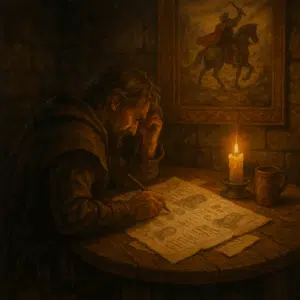Estimated Reading Time: 52 minutes (9818 words)
Every great story exists twice—once in the mind of its creator, and again in the universe where it unfolds. The gap between these two realities is where worldbuilding lives, transforming abstract ideas into living, breathing environments that characters inhabit and readers explore.
The most captivating fictional worlds aren’t static backdrops painted behind character action. They’re dynamic ecosystems where geography shapes culture, history echoes through present conflicts, and seemingly small decisions ripple outward with far-reaching consequences. Yet many writers approach worldbuilding as a checklist exercise, dutifully filling in details without understanding how these elements should interact organically.
The secret to creating truly immersive worlds lies not in having all the answers, but in asking questions that evolve as your understanding deepens. When you establish that gravity works differently on your distant planet, you’re not just making a scientific notation—you’re setting in motion cascading effects that will influence everything from architecture to athletic competition to cultural metaphors about “rising” and “falling.”
The most compelling fictional universes emerge through this iterative questioning process, where each answer you discover seeds new territory to explore. Whether you’re crafting distant planets, reimagined historical periods, or fantasy realms hiding just beyond our own, the right questions transform your world from a collection of interesting facts into a cohesive foundation where your characters and their struggles couldn’t possibly exist anywhere else.
In worldbuilding, asking the right questions transforms your fictional universe from flat backdrop to living ecosystem. While many writers focus on filling in checklists, truly immersive worlds emerge when your questions evolve organically, each answer seeding new territory to explore.
- Start with foundations, not facades: Begin by establishing the fundamental laws and constraints of your world rather than superficial details. Understanding whether gravity works differently or magic exists shapes every subsequent decision you’ll make.
- Let geography dictate culture: Rivers, mountains, and climate aren’t just scenic elements—they determine where civilizations develop, what resources they fight over, and how isolated or connected communities become. Your people’s beliefs will naturally reflect their environment.
- Design systems, not just scenarios: Rather than creating isolated elements, build interconnected systems where political structures, economic forces, and cultural practices influence each other. This creates a framework where compelling conflicts arise organically.
- Build backward from story needs: Identify what your narrative requires, then develop worldbuilding elements that create natural tension or opportunities for your characters. A perfect world makes for a boring story.
- Follow the ripple effects: When establishing a major worldbuilding element—like a magic system or technological innovation—trace how it would realistically transform everyday life, social hierarchies, and cultural beliefs.
- Create living history, not static lore: Develop your world’s past as a series of cause and effect relationships rather than isolated events. History should feel like it’s still unfolding during your story, with consequences still being felt.
- Embrace the iterative journey: Allow early worldbuilding answers to reshape your later questions. The most authentic fictional worlds evolve through multiple passes as you discover new implications of your initial decisions.
Effective worldbuilding isn’t about exhausting every possible detail but creating a cohesive foundation where your characters and their struggles make perfect sense. Let’s explore the questions that will bring your unique world to life.

The Iterative Questioning Approach to Worldbuilding
Moving beyond static checklists to dynamic creation
Worldbuilding isn’t a linear process with a clear endpoint; it’s a recursive exploration where each discovery leads to new questions and deeper understanding. Many writers approach worldbuilding as if completing a questionnaire—filling out forms about currency, government types, and clothing styles without considering how these elements interact. This checklist approach often results in worlds that feel artificial, with disconnected elements that don’t influence each other organically.
The iterative questioning approach transforms this static process into a dynamic one. Rather than trying to answer every possible question about your world before writing, you start with fundamental questions, then allow each answer to generate new, more specific inquiries. When you discover that your desert planet has occasional but catastrophic rainfall, you naturally begin questioning how this would shape architecture, water storage technologies, religious practices around precipitation, and social power structures based on water access.
Consider how J.R.R. Tolkien built Middle-earth not by completing worldbuilding worksheets, but through progressive discovery. His initial linguistic interests led to questions about who would speak these languages, which prompted exploration of their histories, which required understanding geography, and so forth. Each element emerged naturally from previous decisions, creating an interconnected world where languages, migration patterns, and cultural conflicts all made sense together.
This approach means accepting that your first draft of worldbuilding will be incomplete. You might initially determine that your space colony uses algae farming for oxygen and food production, but only in your second iteration realize this would create distinct social classes between maintenance workers and administrators, or specialized religious practices around contamination prevention. The most compelling worlds are those discovered through multiple passes, where early answers create increasingly nuanced questions.
Establishing Natural Laws and Constraints
Physical forces that govern your world
Every fictional world operates under certain physical laws that determine what’s possible within its boundaries. Even when creating universes vastly different from our own, establishing clear natural laws provides the foundation for everything that follows. Consider how gravity shapes not just movement but architecture, athletics, warfare, and even language—a world with lower gravity might develop building styles impossible on Earth, with entirely different concepts of “up” and “down.”
The rules governing life and death create particularly powerful constraints. Does your world feature longer lifespans? This single decision affects inheritance patterns, the pace of cultural change, attitudes toward risk, and the accumulation of wealth. A society where people commonly live to 200 might develop entirely different approaches to education, career changes, and relationship commitment than our own.
Time itself can operate differently. Does your world have irregular seasons lasting years instead of months? This would transform agricultural practices, migration patterns, and economic planning. The length of days and years shapes everything from sleep cycles to religious calendar systems. By establishing these fundamental constraints early, you create natural boundaries within which your creative decisions become both more focused and more meaningful.
Where magic and technology bend reality
Magic systems and advanced technology represent controlled exceptions to natural laws—places where your world deliberately diverges from reality as we understand it. The key to creating compelling magic or technology lies not in making anything possible, but in establishing clear boundaries for what remains impossible. The scope and integration of these magical elements fundamentally shapes whether you’re crafting a high fantasy or low fantasy world, each requiring different approaches to how magic interacts with your established reality. Brandon Sanderson’s First Law of Magic states it simply: “An author’s ability to solve conflict with magic is directly proportional to how well the reader understands said magic.”
When developing systems that bend reality, ask what fuels them. Does magic require physical components that must be harvested or traded? Does technology depend on rare resources that create economic disparities? The most interesting systems come with costs and limitations that generate narrative tension. A healing magic that requires the practitioner to take on the patient’s pain creates moral dilemmas that unlimited healing wouldn’t.
Consider how magical or technological innovations would naturally spread through society. Would powerful interests restrict access? Would religious institutions form around controlling these forces? Would certain applications become taboo after disasters? By thinking of magic and technology as social forces rather than just plot devices, you create systems that feel integrated into your world rather than artificially imposed upon it.
The balance between familiarity and innovation
Creating a world that feels both fresh and believable requires careful balance between the familiar and the novel. Readers need anchoring elements they can understand intuitively—human-like emotions, recognizable physical needs, understandable motivations—while experiencing the wonder of discovering new possibilities. Too much familiarity creates a world that feels derivative; too much innovation risks alienating readers who struggle to connect.
This balance applies even in extreme settings. When Frank Herbert created the desert world of Arrakis in “Dune,” he made the ecology radically different from Earth while keeping human political motivations recognizable. The spice melange was alien, but the colonial resource exploitation it represented felt familiar to readers. This strategic familiarity allowed Herbert to introduce more alien concepts like the Bene Gesserit breeding program without losing his audience.
The most efficient approach is often to cluster your innovations. Rather than changing everything in your world, focus your creative energy on thoroughly exploring the implications of a few significant differences. A story featuring faster-than-light travel might keep Earth-like planetary conditions to help readers focus on the social consequences of rapid interstellar transport rather than getting distracted by multiple layers of worldbuilding complexity.
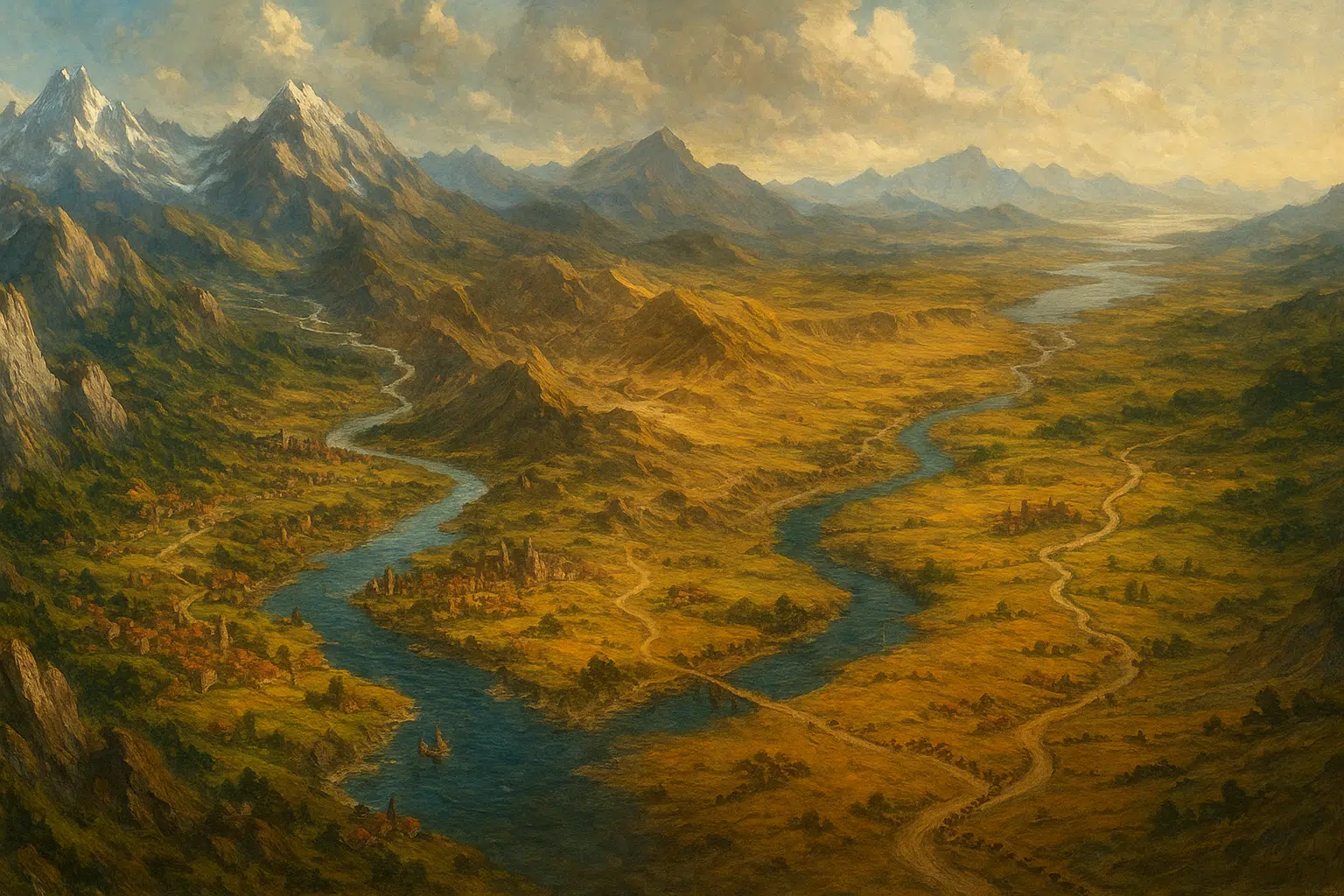
Geographic Foundations That Shape Everything
How landscapes determine where civilizations form
Civilizations don’t emerge randomly—they develop where geography provides advantages for human settlement. Rivers deliver fresh water, fertile soil, and natural transportation routes. Coastal areas offer fishing and international trade. Defensible positions like islands or mountain valleys provide protection from enemies. By mapping your world’s physical features first, you create natural constraints that make your placement of cities and civilizations feel inevitable rather than arbitrary.
The fall of natural barriers often creates cultural fault lines. Mountain passes become contested territory; rivers form political boundaries; islands develop distinct cultural identities. When placing your story’s different cultural groups, consider how geography would naturally separate or connect them. The Pyrenees Mountains created a natural boundary between France and Spain that helped preserve distinct national identities; the Mediterranean Sea simultaneously divided and connected the ancient civilizations surrounding it.
Consider which geographic features would be revered or feared in your world. Volcanoes might become sacred sites despite (or because of) their danger. Rivers could develop religious significance due to their life-sustaining properties. By connecting your geography to cultural development, you create a world where location fundamentally matters to how societies function rather than serving as interchangeable backdrops.
Climate’s influence on daily routines and cultural practices
Climate shapes daily existence in ways both obvious and subtle. Beyond determining what crops can grow, it influences architecture, clothing, social schedules, and even personality stereotypes. Northern cultures develop insulated buildings with steep roofs to shed snow; desert dwellers create narrow, shaded streets and thick-walled homes with minimal windows; tropical inhabitants build elevated structures with maximum airflow.
Daily routines adapt to climate realities. How do people in your world manage extreme heat or cold? Do they adopt siestas during scorching afternoons? Do they perform hard labor during winter mornings before temperatures drop too low? Weather patterns influence everything from meal timing to courtship practices. A culture with predictable monsoon seasons might develop elaborate indoor activities for the rainy months, creating different social dynamics than places with more consistent weather.
Climate also affects cultural attitudes toward time and planning. Societies with extreme seasonal variations must develop long-term planning and food preservation techniques to survive winters. Those in more temperate regions might develop more flexible, present-focused attitudes. Ask how your world’s climate would shape psychological outlooks as well as physical adaptations, creating cultures whose fundamental values reflect their environmental challenges.
Resource distribution and its impact on power dynamics
The uneven distribution of resources inevitably creates power imbalances that shape political and economic systems. Rare materials become sources of wealth and conflict, determining which regions hold advantage over others. When developing your world’s resource map, consider not just what exists where, but how accessible these resources are with available technology, and who controls the extraction and trade routes.
Some resources create absolute necessities, while others represent luxury or strategic advantage. Control of water sources gives fundamental leverage over neighboring regions; access to metals determines military capability; possession of specialized crops like spices or drugs generates wealth through trade. The specific resources you make valuable in your world will shape which territories are coveted and which groups hold power.
Resource depletion and environmental damage create dynamic historical arcs. Ancient civilizations often collapsed when they exhausted nearby resources or damaged their environments beyond sustainability. Consider how your world’s past civilizations might have risen and fallen based on resource exploitation patterns. Did they over-hunt certain animals? Did deforestation change rainfall patterns? Did mining contaminate water supplies? These historical patterns create believable ruins and abandoned regions for your current-era characters to explore.
From Geography to Human Experience
Settlement patterns that make historical sense
Human settlement follows predictable patterns based on geographic advantages. The earliest permanent communities typically form near reliable freshwater sources with good agricultural potential. As population grows, settlements expand outward along rivers, coastlines, and fertile valleys before moving into more challenging territories. By mapping your fictional settlements according to these natural progression patterns, you create a world where population distribution feels organic rather than arbitrary.
Defensive considerations heavily influence historical town and city placement. Settlements near borders or valuable resources often occupy naturally defensible positions—islands, peninsulas, hilltops, or locations with limited approaches. Interior communities in stable regions might spread across flatlands optimized for agriculture rather than defense. These patterns persist in city layouts, with older sections often located on higher ground or surrounded by ancient walls, while newer districts expand into previously unsafe lowlands or plains.
Consider how transportation technology affects settlement patterns. Societies limited to foot and animal transportation develop different community distributions than those with sailing ships, railways, or aircraft. Maximum travel distances between settlements typically correspond to a day’s journey with available technology. Towns in pre-industrial settings often appear every 20-30 miles along major routes—the distance travelers could reasonably cover between overnight stops. These organic spacing patterns create worlds that feel functionally realistic rather than artificially constructed.
Trade routes as cultural crossroads
Trade routes function as the circulatory system of civilization, moving not just goods but ideas, technologies, religions, and cultural practices between otherwise isolated communities. By mapping your world’s major trade pathways, you create natural channels for cultural exchange and conflict that drive historical development. These economic and cultural exchange patterns become powerful narrative mechanics that can drive plot development organically, creating story conflicts that emerge naturally from your world’s established systems rather than feeling artificially imposed. Mountain passes, river confluences, natural harbors, and oasis stops become inevitable crossroads where cultures collide and transform one another.
These crossroads generate distinctive cultural hybrids as merchants settle, intermarry, and blend traditions from their origins with local practices. Port cities develop multicultural neighborhoods; desert trading posts create unique fusion cuisines; mountain pass settlements develop specialized services catering to diverse travelers. The personalities of these junction communities often differ markedly from their parent cultures, fostering more cosmopolitan attitudes and practical multilingualism.
Trade routes also spread disease, conquest, and revolutionary ideas. The Silk Road transmitted both bubonic plague and Buddhism across continents; maritime trade routes enabled both colonization and the spread of democratic ideals. When developing your world’s history, consider how its major exchange pathways functioned as superhighways for transformative forces, both constructive and destructive. These trade-driven transformations create natural historical arcs and explain why certain ideas penetrated some regions while bypassing others.
How isolation versus connectivity shapes worldviews
The degree of connection or isolation fundamentally shapes cultural psychology. Isolated communities—whether on islands, in mountain valleys, or deep forests—develop stronger traditional identities, more uniform beliefs, and greater suspicion of outsiders than connected regions experiencing regular cultural exchange. These isolated pockets become natural preservers of ancient practices and beliefs that have died out elsewhere, creating interesting contrasts between traditional enclaves and cosmopolitan centers.
Connected regions develop more dynamic, adaptable worldviews but may struggle with questions of cultural identity and stability. Coastal trading societies typically display greater tolerance for difference, more rapid technological adoption, and more flexible social structures than interior communities. This creates natural tensions between progressive and conservative elements within your world, with geography often determining which values predominate where.
The introduction of connectivity to previously isolated regions produces predictable cultural shockwaves. Traditional authorities lose influence; younger generations adopt foreign ideas; economic systems transform as local production faces external competition. These connectivity transitions—whether through new mountain passes, canal systems, or telecommunication technology—create natural periods of social upheaval in your world’s history. Cultures rarely move smoothly from isolation to connection without significant resistance and conflict, providing rich material for storytelling.
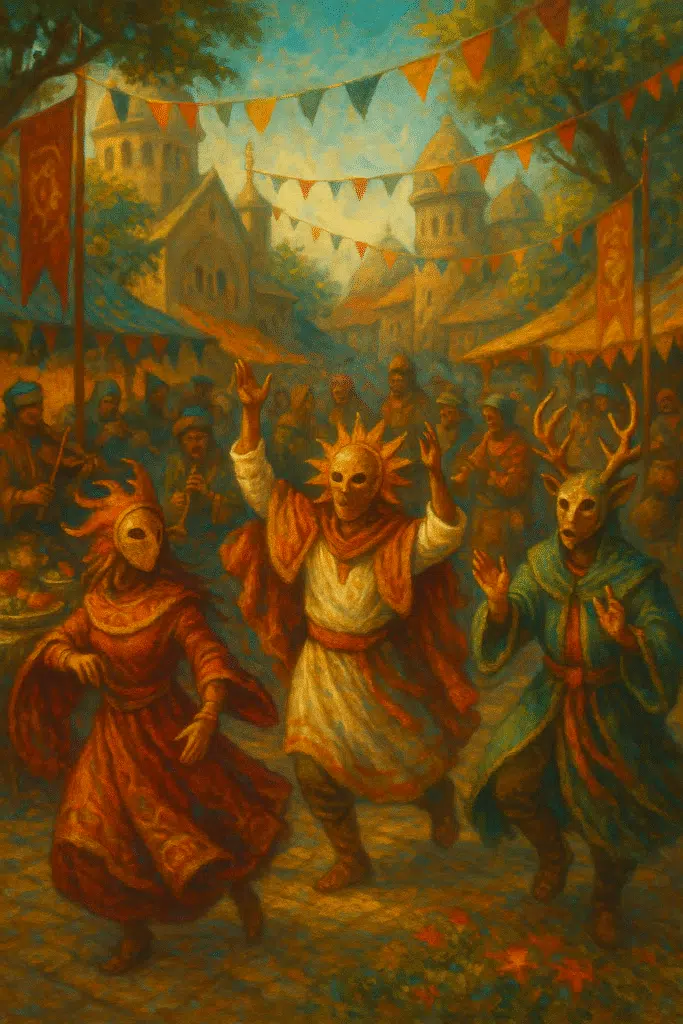
Cultural Systems as Living Organisms
Beyond costumes and customs
Superficial worldbuilding often reduces cultures to collections of distinctive visual markers—unusual clothing, architectural styles, food preferences—without understanding the underlying systems that generate these surface expressions. Authentic worldbuilding recognizes cultures as complex adaptive systems responding to specific environmental challenges, historical experiences, and neighboring influences. The distinctive elements that make a culture recognizable emerge organically from these deeper structural forces rather than being arbitrarily assigned.
Cultures develop internal coherence, with different elements reinforcing rather than contradicting each other. Religious beliefs typically align with economic realities—agricultural societies develop fertility gods, while nomadic herders create portable deities. Family structures reflect survival needs—extended families flourish where agricultural labor requires many hands, while nuclear families emerge in mobile, industrialized settings. When developing cultural systems, test whether their various elements would naturally evolve together or would create unsustainable contradictions.
The most distinctive cultural practices often begin as practical solutions to specific problems. Elaborate food preservation methods develop in regions with extreme seasonal variations; complex water-sharing systems emerge in arid environments; matrilineal inheritance patterns appear where paternity is difficult to establish. These culturally-specific adaptations become the foundation for authentic character development, as individuals shaped by these practices carry distinctive worldviews and behavioral patterns that reflect their environmental origins. By starting with the challenges your fictional cultures would face, you can develop distinctive practices that emerge logically from their circumstances rather than seeming arbitrarily exotic.
Social hierarchies and their justifications
Every society creates hierarchies that determine who holds power, privilege, and prestige, but the bases for these rankings vary enormously across cultures. Some societies prioritize age, others ancestry, accumulated wealth, religious knowledge, martial prowess, or technical expertise. The specific values that determine social standing reveal what a culture truly considers important for its survival and prosperity. A society that ranks warriors above merchants reveals different priorities than one where traders outrank soldiers.
These hierarchies require justification systems—narratives explaining why the existing order is natural, inevitable, or divinely ordained. Religious beliefs often codify social hierarchies by attributing them to sacred origins. Educational systems reinforce them by controlling who receives what knowledge. Even architectural designs express and reinforce social divisions through spatial arrangements. When developing your world’s cultures, consider how they justify their existing power structures and what mechanisms maintain these justifications against potential challenges.
Status markers evolve to communicate social position within these hierarchies. Restricted clothing styles, specialized language patterns, consumption habits, and even posture and movement styles develop to distinguish between ranks. These markers typically require resources or training inaccessible to lower ranks, making them difficult to counterfeit. The specific status markers you develop for your cultures should logically connect to their core values—scholarly societies might display status through rare books and specialized vocabulary, while warrior cultures emphasize bodily modifications and weapon quality.
The interplay between belief systems and daily life
Religious and philosophical beliefs don’t exist separately from everyday existence—they permeate daily routines through rituals, taboos, ethical frameworks, and decision-making processes. In developing your world’s belief systems, consider how they would manifest in ordinary moments, not just during special ceremonies. How do people greet each other? What blessings or phrases punctuate daily transitions? What foods are avoided or required? What gestures ward off misfortune during routine activities?
Belief systems typically provide frameworks for understanding misfortune and success. Are illnesses attributed to spiritual imbalances, ancestral displeasure, or natural causes? Is prosperity seen as divine reward, personal achievement, or community success? These interpretative frameworks powerfully shape how characters respond to story events, influencing whether they seek medical treatment, religious intervention, or social solutions to their problems.
Significantly, belief systems rarely achieve perfect consistency. Most cultures contain competing interpretative frameworks, with traditional religious explanations coexisting alongside newer scientific or philosophical approaches. This creates natural tensions as characters navigate different explanatory models. A healer might combine ritual purification with herbal medicine; a ruler might consult both economic advisors and religious oracles. These contradictions create realistic complexity in your world’s cultures while providing opportunities for characters with different perspectives to conflict or collaborate.
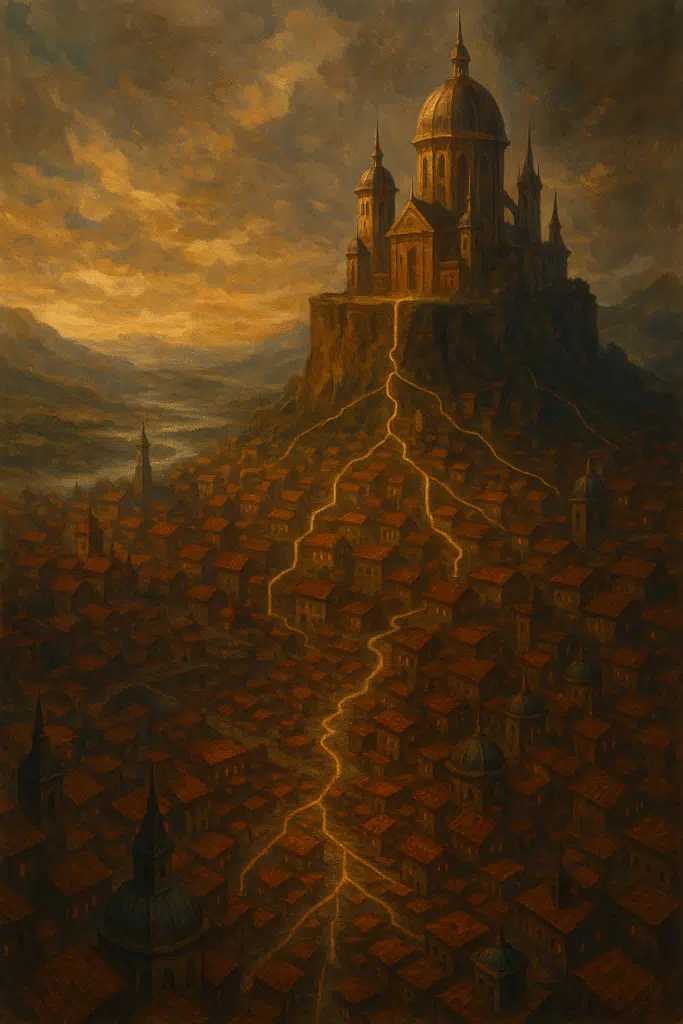
Power Structures and Their Foundations
Who rules and why others accept it
Authority systems don’t emerge arbitrarily—they develop from specific historical circumstances and persist because they serve particular interests or address specific social needs. When creating your world’s governance structures, consider what problems they originally solved and whose interests they continue to serve. Feudal systems typically emerged where central authority collapsed and local protection became necessary; bureaucratic states developed where complex resource management required specialized administration; theocracies formed where religious institutions provided stability amid chaos.
Legitimacy—the perceived right to rule—comes from different sources in different societies. Some systems derive authority from divine selection, others from ancestral inheritance, democratic processes, proven competence, or possession of specific knowledge. The source of legitimacy fundamentally shapes how power transfers between individuals and how rulers must behave to maintain their position. A king ruling by divine right performs different rituals and faces different constraints than a meritocratic leader who must repeatedly demonstrate competence.
Power rarely resides exactly where formal structures suggest. Behind official rulers often stand influential advisors, wealthy financiers, military leaders, or religious authorities whose support remains crucial for maintaining control. When mapping your world’s power structures, consider both the formal hierarchy visible to ordinary citizens and the shadow hierarchies operating behind it. These gaps between apparent and actual authority create natural spaces for intrigue, corruption, and reform movements that drive compelling stories.
Economic realities behind political facades
Political power ultimately rests on economic foundations that determine which systems remain viable in particular environments. Absolute monarchies require concentrated wealth that can support lavish courts; representative democracies typically emerge where middle classes gain economic influence; nomadic confederations develop where resources are too dispersed to support permanent centralized authorities. The economic base your world provides must reasonably support the political structures you place upon it.
Control of essential resources creates fundamental power regardless of official titles. Those who command food production, water sources, essential trade routes, or military supplies often exercise more practical authority than those holding ceremonial positions. When developing your world’s political dynamics, map who controls what resources and how this economic reality aligns with or contradicts the formal power structure. These contradictions create natural tension points where change becomes inevitable as economic reality eventually forces political adjustment.
Taxation systems reveal the true nature of political relationships more honestly than official declarations. How wealth flows from producers to power centers—through direct seizure, formal taxation, religious offerings, or service requirements—shows who truly holds authority and how they maintain it. Different taxation methods create different social dynamics: agricultural societies often collect taxes in kind rather than currency; conquest states may demand tribute from subjugated regions; commercial powers might tax trade rather than production. These economic arrangements shape citizens’ relationship with authority more profoundly than official ideologies.
How governance adapts to your world’s unique challenges
Governance systems evolve to address specific challenges presented by geography, resource distribution, external threats, and internal tensions. Desert kingdoms develop water management bureaucracies; mountain confederations create systems for resolving territorial disputes; island nations establish elaborate naval administrations. By considering what unique problems your fictional societies would face, you can develop governance structures that feel necessary rather than arbitrary.
Scale fundamentally shapes governance methods. Pre-industrial societies face natural limits to how much territory they can effectively control with available communication and transportation technology. Without telephones or rapid transport, central authorities cannot micromanage distant regions, leading to devolved authority structures where local representatives exercise significant autonomy. The technology level you establish for your world should align with the governance scale you depict—vast empires without corresponding communication technology create believability problems unless you develop specialized solutions like magical communication or genetically enhanced messenger animals.
External pressures force governance adaptation more powerfully than internal reform movements. Societies facing persistent military threats develop different institutions than those enjoying natural protection; those dependent on international trade create different regulatory systems than self-sufficient isolationists. When developing your world’s political evolution, consider how neighboring powers, resource competition, and environmental challenges would force transformation of governing institutions regardless of internal preferences. These external pressures create natural historical arcs as systems adapt or collapse when facing changing circumstances.
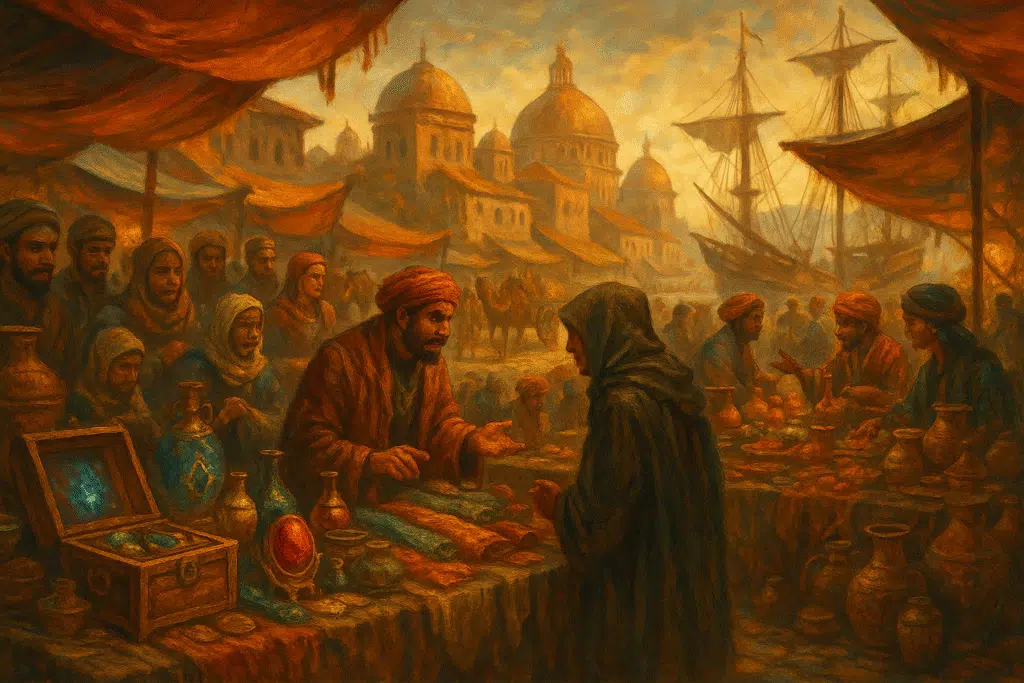
The Economy of Your World
Beyond simple currency systems
Economic systems involve far more than what coins people use—they encompass production methods, distribution networks, labor relationships, and value determination mechanisms that fundamentally shape daily experience. When developing your world’s economy, consider what gets produced where, by whom, under what conditions, and how it reaches its ultimate users. These production and distribution chains create natural interdependencies between regions and social classes that generate both cooperation and conflict.
Different economic sectors typically operate under different rules within the same society. Agricultural production, craft manufacturing, resource extraction, and knowledge services often function with distinct ownership structures, labor practices, and exchange methods. A world with feudal agriculture might simultaneously contain guild-based urban manufacturing and free-market luxury trade. These sectoral differences create natural social tensions as participants in different economic spheres develop conflicting values and interests.
Status goods serve essential social functions beyond their practical utility by visibly marking social position and group membership. Whether through distinctive clothing, architectural styles, food practices, or leisure activities, status display allows instant recognition of social position within complex societies. The specific status markers you develop for your world should connect to its core resource challenges—water-scarce societies might display status through cleanliness and gardens; metal-poor regions might value well-crafted weapons above gold. These culturally-specific value systems create more distinctive economies than simply inventing unusual currencies.
Resource scarcity and its ripple effects
Every society forms around the management of scarce resources—whether water, arable land, essential minerals, specialized knowledge, or manufactured goods. By identifying what critical resources would be naturally limited in your world, you create foundation points for realistic conflict, cooperation, and cultural development. Scarcity drives innovation, motivates trade, justifies conquest, and shapes cultural values more powerfully than abundance.
Scarcity rarely affects all social groups equally. Political systems typically develop to manage resource distribution in ways that favor particular groups, creating structural inequalities that persist across generations. When mapping resource access in your world, consider which groups would control essential supplies and what mechanisms would maintain their privileged position. These unequal distribution patterns create natural social tensions that drive compelling stories about justice, revolution, or reform.
Perceived scarcity often proves as influential as actual scarcity. Societies frequently develop extravagant consumption patterns or destructive resource competitions based on artificial limitations created through hoarding, prestige systems, or misinformation. The diamond market represents a classic example—perceived scarcity maintained through controlled supply creates value far beyond practical utility. By including both actual and manufactured scarcity in your world’s economy, you create complex motivational systems that reflect the psychological as well as material aspects of economic behavior.
How trade shapes international relations
Trade relationships create power dynamics independent of military capability. Societies that produce essential goods exercise leverage over their trading partners; those dependent on imports become vulnerable to economic coercion. When mapping your world’s international relations, consider which regions produce what necessities and luxuries, creating natural patterns of dependency and influence. These economic realities often contradict apparent political relationships, with hostile nations maintaining crucial trade links while nominal allies compete economically.
Trade routes require protection, creating security challenges that shape military development and international cooperation. Safe passage through third-party territories becomes diplomatically crucial; piracy or banditry along key routes drives military innovation; strategic chokepoints like mountain passes or narrow seas gain importance disproportionate to their size. By mapping your world’s major trade pathways, you create natural focal points for international tension and cooperation regardless of formal political boundaries.
Trade brings cultural exchange that transforms societies regardless of political intentions. Merchants carry not just goods but ideas, technologies, religious beliefs, and social practices between regions. Trading centers naturally develop more cosmopolitan attitudes than isolated hinterlands, creating internal cultural divisions that complicate national identity. By tracing how trade connections would influence cultural development in your world, you create realistic patterns of innovation adoption, religious conversion, and ideological change that reflect historical patterns while remaining specific to your created context.
History as Ongoing Consequence
Creating conflicts with roots and branches
History in compelling fictional worlds isn’t a static backdrop—it’s a dynamic force that continues shaping current events through lingering consequences and unresolved tensions. Rather than creating historical timelines as collections of disconnected events, develop causal chains that connect past actions to present circumstances. A territorial war fought centuries ago might still determine modern border tensions, resource claims, and cultural antagonisms regardless of how many generations have passed since the original conflict.
The most believable conflicts have both immediate triggers and deeper historical causes. Surface-level disputes over trade regulations, border incidents, or diplomatic insults typically mask fundamental conflicts over resources, security fears, or identity threats rooted in historical experience. By giving your world’s conflicts this multilevel structure—combining immediate provocations with historical grievances—you create tensions that resist simple resolution while feeling authentically complex.
Historical perspective varies dramatically between different groups experiencing the same events. Victories for one side represent devastating defeats for another; liberation for some means loss of privilege for others; heroic resistance narratives counter imperial civilization stories. When developing your world’s history, consider how the same pivotal events would be remembered and interpreted differently by various participants. These competing historical narratives create natural communication barriers between groups who literally cannot agree on what happened in their shared past.
Generational memory and cultural trauma
Societies carry collective memories that shape their behavior long after the individuals who experienced formative events have died. These memories transmit through formal education, family stories, commemorative rituals, literature, art, and physical monuments that keep historical consciousness alive across generations. Particularly traumatic events—genocides, enslavements, forced migrations, natural disasters—create cultural wounds that influence group psychology and decision-making far beyond their immediate aftermath.
Different cultures preserve different historical timeframes. Some societies maintain active cultural memory stretching back thousands of years, while others focus primarily on recent centuries. The depth of historical consciousness you establish for your world’s cultures should reflect their record-keeping technology, stability of settlement, and cultural values around ancestry and tradition. Oral cultures typically preserve different types of historical information than literate societies, focusing on genealogical relationships and moral lessons rather than specific dates and quantities.
Historical memory often distorts through simplification, heroization, and vilification as complicated events transform into cultural touchstones. Foundation stories, golden ages, and catastrophic breaks become simplified and magnified over time, evolving from messy historical reality into powerful cultural symbols. When developing your world’s historical consciousness, include these mythologized interpretations alongside more accurate accounts, recognizing that what groups believe about their history often influences their behavior more powerfully than what actually occurred.
Abandoned places and their lingering stories
Physical environments preserve history through ruins, repurposed structures, boundary markers, and altered landscapes that continue influencing contemporary experience long after their creators have disappeared. These remnants create both practical constraints and psychological effects on current inhabitants who must navigate spaces shaped by previous occupants. A city built around ancient ruins develops different architectural patterns than one constructed on open terrain; farmland reclaimed from abandoned settlements contains old road networks, boundary stones, and buried foundations that influence current usage patterns.
Abandoned places generate powerful emotional and cultural responses. Ruins evoke mortality and civilizational fragility; abandoned technologies raise questions about lost knowledge; empty settlements suggest cautionary tales about environmental mismanagement or social collapse. By incorporating these emotionally resonant abandoned spaces into your world, you create natural locations for reflection, mystery, and discovery that enrich storytelling possibilities while reinforcing your world’s historical depth.
Repurposing previous structures creates distinctive layered environments that visually represent historical continuity and change. Temples converted to secular use, defensive walls incorporated into ordinary buildings, ancient roads that become modern highways—these adaptations demonstrate how past and present interact in material form. When designing your world’s built environments, consider how current inhabitants would practically adapt previous constructions rather than constantly building anew. These layered environments create visually distinctive settings while naturally revealing historical information through physical surroundings rather than exposition.
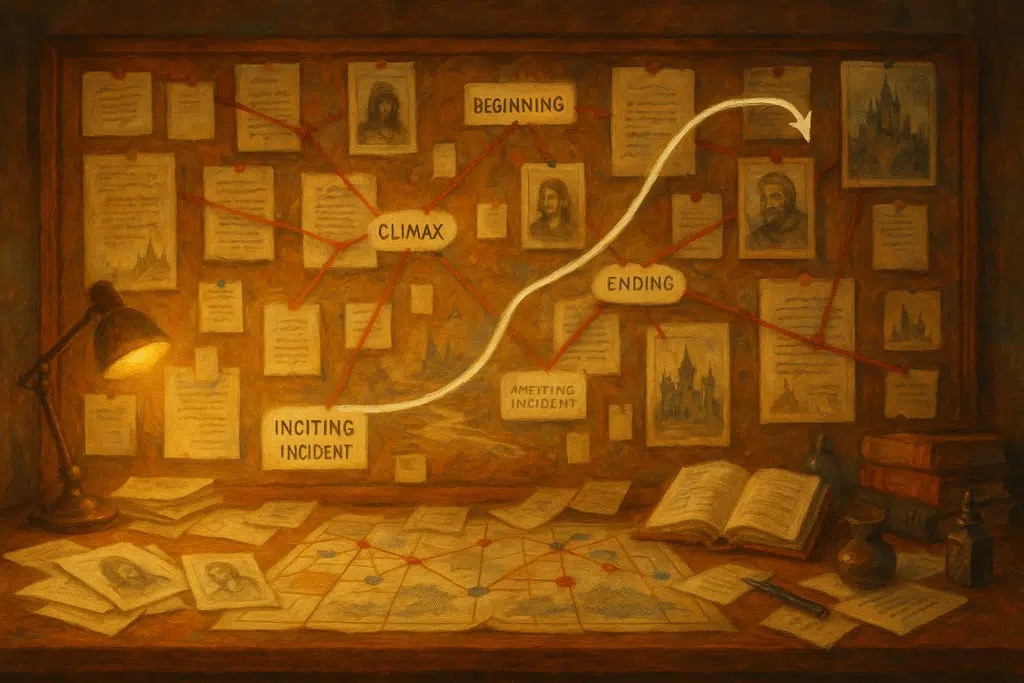
Working Backward from Narrative Needs
Identifying what your story requires
Effective worldbuilding serves narrative purpose rather than existing for its own sake. Before developing elaborate details about your fictional universe, identify what elements your specific story absolutely requires. A political thriller needs detailed governance systems but might function with minimal information about religious practices; a coming-of-age story requires clear cultural initiation rituals but might need only sketchy information about international relations. By focusing your worldbuilding efforts on elements directly relevant to your narrative, you create deeper, more purposeful fictional environments while avoiding worldbuilder’s disease—endless detailing of elements that never appear in your actual story.
Stories require certain foundational tensions to generate compelling conflict. These might include resource scarcity, power imbalances, cultural misunderstandings, technological transitions, or environmental pressures. By identifying what tensions would most effectively drive your specific narrative, you can develop worldbuilding elements that naturally generate the conflicts your story requires without forcing characters into artificial situations. A world with dwindling water supplies naturally creates resource conflicts; a society in technological transition inevitably generates generational tensions.
Character agency depends on meaningful choices, which require constraints that make decisions consequential. Paradoxically, characters gain freedom through limitations that make their choices matter. This principle becomes especially important for game masters and interactive storytellers, who must balance worldbuilding constraints with player agency to create compelling collaborative narratives. When developing your world, identify what constraints would create the most meaningful decision points for your specific characters. A healer character faces more interesting choices in a world where medical resources are limited; a leadership character encounters more complex decisions in a system with competing power centers. These purposeful constraints enhance rather than restrict storytelling possibilities.
Creating natural obstacles through worldbuilding
The most compelling story obstacles emerge naturally from worldbuilding rather than appearing arbitrarily to challenge protagonists. Physical environments create natural barriers—rivers that must be crossed, mountains that must be traversed, deserts that must be survived. Social systems generate inevitable friction—class boundaries that restrict movement, cultural taboos that prevent direct communication, legal structures that criminalize necessary actions. By developing your world’s physical and social geography to inherently obstruct character goals, you create challenges that feel inevitable rather than contrived.
Conflicting values systems create particularly effective obstacles because they force difficult choices rather than simple physical challenges. Characters navigating between cultures with fundamentally different ethical frameworks must decide which values to prioritize rather than merely solving technical problems. A diplomat operating between a culture that values honesty above all and one that considers directness deeply insulting faces no simple solution—either choice violates important values. By building conflicting ethical systems into your world, you create dilemmas without easy answers.
Timing constraints gained through worldbuilding create natural urgency without arbitrary deadlines. Seasonal patterns—monsoon seasons that make travel impossible, winter conditions that threaten survival, migratory patterns that offer limited windows of opportunity—create countdown pressures embedded in your world’s natural functioning. Religious or social calendars similarly create fixed timeframes—coronation ceremonies that cannot be postponed, ritual periods when certain activities become forbidden, astrological alignments believed to enable particular actions. These world-based timing pressures create authentic urgency while reinforcing your setting’s distinctive characteristics.
When to leave strategic gaps in your creation
Complete worldbuilding is neither possible nor desirable—strategic ambiguity creates space for reader imagination and narrative flexibility. Deliberately leaving certain aspects of your world undefined allows readers to fill gaps with their own interpretations, increasing engagement through co-creation. These strategic gaps also provide room for story development without contradicting established facts. When determining which elements to fully develop and which to leave undefined, prioritize clarity on aspects directly impacting plot and character motivation while allowing peripheral elements to remain flexible.
Mystery functions as a legitimate worldbuilding technique when carefully managed. Unexplained phenomena, contested historical interpretations, and ambiguous causality create intriguing depth when presented as explicitly unknown within the world rather than resulting from creator oversight. Characters who acknowledge and respond to these in-world mysteries without resolving them create authentic complexity. Ancient technologies whose functioning principles remain mysterious, historical events with conflicting interpretations, or natural phenomena not fully understood by the world’s inhabitants all create legitimate ambiguity that enhances rather than undermines believability.
Worldbuilding often benefits from focusing on systems rather than specifications. Defining how magical energy responds to different materials proves more narratively useful than cataloging exact spell effects; establishing how social mobility functions provides more storytelling flexibility than detailing every noble family’s history. This systems-based approach creates frameworks within which you can develop specific details as needed while maintaining internal consistency. It also allows readers to accurately predict how unknown elements would function within your world, creating satisfying cohesiveness without requiring encyclopedic detailing.
The Magic of Constraint
Why limitations create more interesting worlds
Unlimited possibilities paradoxically create less interesting fictional worlds than those operating under clear constraints. Without meaningful limitations, conflicts lack tension, achievements lose significance, and characters face no consequential choices. The most compelling fictional universes establish what cannot be done as carefully as what can, creating frameworks where actions carry meaningful consequences because alternatives remain genuinely impossible. These limitations foster creative problem-solving within established constraints rather than allowing arbitrary solutions that undermine narrative tension.
Physical constraints create distinctive adaptation patterns that differentiate your world from generic templates. Societies developing in extreme environments—underwater civilizations, high-gravity planets, arctic conditions—must solve specific survival problems that generate unique technologies, social structures, and cultural values. By establishing significant physical constraints for your world, you create natural pressures that drive distinctive development patterns unlike standard fantasy or science fiction settings.
Resource limitations drive innovation more effectively than abundance. Societies facing specific scarcities develop specialized technologies, social practices, and value systems to manage critical shortages. Desert cultures create elaborate water conservation technologies; metal-poor regions develop alternative construction techniques; societies with limited arable land establish specialized intensive farming methods. By identifying what crucial resources would be scarce in your world, you create innovation pressures that generate distinctive cultural adaptations while providing natural conflict sources as groups compete for limited necessities.
Balancing wonder with consistent rules
The most satisfying fictional worlds combine wonder-inducing elements with consistent underlying principles that make these marvels comprehensible rather than arbitrary. Without removing the sense of mystery and awe, establish foundational rules that govern how extraordinary elements function within your world. These principles need not be fully understood by characters or explicitly explained to readers, but they should provide consistent frameworks that allow readers to develop accurate expectations about how your world functions.
Rule systems need not mirror scientific principles but must maintain internal consistency to remain satisfying. Magic systems based on emotional resonance rather than physics can work perfectly well provided they follow their own established patterns consistently. The specific organizing principles matter less than their reliable application. When developing supernatural or highly advanced technological elements, establish fundamental laws governing their operation and test new applications against these principles rather than introducing capabilities that contradict previously established limitations.
Mystery remains essential even in rule-bound worlds. The most compelling fictional universes contain elements that follow consistent principles while retaining wonder and emotional impact. Like music that follows harmonic rules while still evoking powerful emotions, fictional marvels can operate according to established patterns without becoming mere technical systems. By developing supernatural or advanced technological elements with both consistent rules and emotional resonance, you create worlds that satisfy both intellectual and imaginative engagement.
Unexpected consequences of supernatural elements
Supernatural elements should transform societies rather than simply adding flashy capabilities to an otherwise unchanged world. When introducing magic, psychic abilities, or other reality-altering forces, trace how these elements would realistically reshape economic systems, power structures, and cultural practices. A world where elemental magic enables weather control would develop fundamentally different agricultural practices, architectural styles, and military strategies than one limited to normal physical forces. These transformative consequences create distinctive worlds rather than generic backdrops with superficial supernatural additions.
Power balancing mechanisms naturally evolve in worlds with supernatural elements. Societies develop countermeasures against magical threats, regulatory systems to prevent abuse, and specialized roles to manage extraordinary capabilities. Without such balancing factors, supernatural abilities would completely dominate ordinary activities rather than existing alongside them. When developing magical or psychic elements, simultaneously develop the limitations, countermeasures, and regulatory systems that would naturally emerge in response, creating balanced dynamics rather than overwhelming advantages.
Supernatural elements naturally generate specialized vocabularies, ethical frameworks, and philosophical perspectives as societies incorporate extraordinary capabilities into their understanding of reality. Religious systems develop explanations for supernatural forces; ethical codes establish boundaries between acceptable and forbidden applications; specialized terminology evolves to describe non-ordinary experiences. By developing these cultural responses alongside the supernatural capabilities themselves, you create worlds where extraordinary elements feel integrated into social fabric rather than artificially imposed upon it.

Technology’s Transformative Effects
How innovations reshape society
Technologies transform daily existence far beyond their immediate applications, reshaping social structures, cultural values, and personal psychology in ways their creators rarely anticipate. When introducing fictional technologies, consider their second-order and third-order effects—how they would alter family structures, educational systems, status markers, and ethical frameworks beyond their primary functions. Communication technologies reshape community boundaries; transportation innovations transform settlement patterns; medical advances alter attitudes toward risk and mortality. These cascading consequences create realistic technological integration rather than superficial futurism.
Different technologies spread at different rates depending on their compatibility with existing infrastructure, cultural values, and economic incentives. Innovations that require minimal support structures, align with existing values, and offer immediate benefits spread rapidly even in resource-limited settings. Those requiring extensive infrastructure development, contradicting established values, or offering delayed benefits face adoption barriers regardless of their theoretical superiority. When introducing new technologies to your world, consider what factors would accelerate or impede their adoption rather than assuming uniform implementation.
Technologies create both winners and losers as they disrupt existing power structures and economic systems. Groups benefiting from current arrangements typically resist innovations threatening their advantages; those excluded from existing systems often embrace disruptive technologies offering new opportunities. These differential impacts create natural conflict around technological change independent of the innovations’ theoretical merits. By mapping which groups would gain or lose influence from your world’s technological developments, you create realistic friction points around innovation adoption.
The gap between invention and adoption
Technological capability frequently outruns social adaptation, creating periods where technical possibilities exceed cultural readiness. This gap between what becomes technically possible and what society considers acceptable creates natural tension points as groups debate proper boundaries and applications. Nuclear technology enables both power generation and mass destruction; genetic manipulation allows both disease prevention and human enhancement; digital recording enables both knowledge preservation and surveillance. By exploring these capability-acceptance gaps in your fictional technologies, you create realistic ethical dilemmas specific to your world.
Infrastructure requirements create natural adoption delays between technical invention and widespread implementation. Transportation systems need physical networks; communication technologies require compatible devices; energy innovations demand distribution systems. These infrastructure dependencies create natural transition periods where new and old technologies operate simultaneously rather than experiencing instantaneous replacement. By acknowledging these implementation realities, you create more believable technological transition periods where characters navigate between emerging and established systems.
Social resistance frequently delays adoption of even beneficial technologies when they threaten established identities, practices, or beliefs. Professional groups resist automation threatening their expertise; religious institutions question innovations contradicting traditional understandings; cultural identity often becomes attached to traditional methods regardless of efficiency. These resistance patterns reflect genuine concerns about social cohesion and meaning rather than simple irrationality. By incorporating realistic resistance alongside innovation enthusiasm, you create more nuanced technological transition landscapes that reflect actual adoption patterns.
Technological inequality and its story potential
Access to technology rarely distributes evenly across social groups or geographical regions, creating capability disparities that generate both conflict and cooperation opportunities. Core regions typically gain access to innovations before peripheral areas; wealthy classes adopt new capabilities before ordinary citizens; military applications often precede civilian uses. These uneven distribution patterns create natural settings where characters from different technological contexts interact, generating friction, curiosity, or exploitation opportunities based on capability differentials.
Technological adaptation frequently follows distinctive patterns when innovations transfer between cultures rather than developing indigenously. Adopting societies often implement technologies differently than their originators, adapting innovations to local conditions, values, and needs rather than precisely replicating original applications. These adaptive implementation patterns create distinctive technology variants reflecting specific cultural contexts. By considering how different societies would modify imported technologies to suit their particular circumstances, you create technological diversity that reflects cultural variation rather than universal implementation.
Technology dependence creates vulnerability alongside capability enhancement. Societies adapting to technological assistance become increasingly reliant on innovations that may prove fragile under certain conditions or susceptible to deliberate disruption. Energy grid dependencies, food production technologies, or communication systems create critical vulnerabilities when interrupted. By incorporating these technological fragilities into your world, you create natural crisis points where characters must navigate between dependency and resilience, generating compelling conflict situations specific to your technological landscape.
Worldbuilding in Different Narrative Formats
Adapting depth for novels versus short fiction
Different narrative forms require different worldbuilding approaches, with varying depth appropriate to each format. Novels support extensive worldbuilding through their length and pacing, allowing gradual revelation of complex systems across multiple scenes. Short stories must establish rich worlds through implication and selective detail rather than comprehensive explanation. Flash fiction requires even more efficient worldbuilding through single powerful details that suggest broader systems. By matching your worldbuilding approach to your chosen format, you create immersive experiences without overwhelming narrative momentum.
The worldbuilding revelation pattern differs significantly between formats. Novels can begin with limited context and gradually expand reader understanding across chapters; short stories typically require earlier establishment of critical worldbuilding elements to build coherent narratives within limited space. When adapting worldbuilding between formats, identify which elements require explicit explanation and which can function through implication based on available narrative space. The same fictional world might be revealed very differently in a novel series versus a standalone short story.
Character knowledge relative to reader knowledge varies between formats. Novels allow space to show both character familiarity with their environment and reader discovery of unfamiliar elements; shorter forms often require choosing between these approaches. When working in condensed formats, decide whether to prioritize character perspective (showing the world as familiar to protagonists) or reader discovery (highlighting unusual elements through character interaction). These perspective choices fundamentally shape how worldbuilding information emerges through narrative.
Visual storytelling considerations
Visual narratives—whether graphic novels, films, games, or illustrations—present worldbuilding through direct observation rather than verbal description, requiring design-oriented approaches. Visual worldbuilding relies heavily on implied systems suggested through observable details—architecture revealing social hierarchies; clothing indicating status or function; environmental design suggesting climate adaptation. When developing worlds intended for visual representation, focus on tangible elements that communicate broader systems through their visible characteristics rather than requiring explicit explanation.
Visual mediums excel at establishing atmosphere and emotional tone through environmental design, lighting, color palettes, and composition choices. These elements communicate essential worldbuilding information about social conditions, historical context, and power dynamics without requiring verbal exposition. A city shown with sharp division between ornate upper levels and industrial lower sections immediately suggests social stratification; a landscape dominated by angular, imposing structures creates different expectations than one featuring organic, flowing designs. These visual storytelling techniques communicate worldbuilding efficiently when thoughtfully implemented.
Character design in visual narratives functions as walking worldbuilding, with clothing, tools, physical adaptations, and ornamentation revealing cultural systems, technological development, and social position. These design elements communicate information both through their practical functions and their symbolic significance within the fictional culture. By developing coherent visual languages for different cultural groups—distinctive color schemes, recurrent motifs, consistent material preferences—you create recognizable visual identities that efficiently communicate worldbuilding information through character appearance alone.
Interactive media and player-driven exploration
Interactive narratives—including games, interactive fiction, and role-playing experiences—present unique worldbuilding opportunities and challenges through their non-linear exploration possibilities. These formats must support player-directed discovery while maintaining coherent experiences regardless of exploration order. This requires developing consistent underlying systems rather than fixed narrative revelations, allowing players to learn through experimentation and observation rather than prescribed information delivery.
Environmental storytelling becomes particularly powerful in interactive formats, with physical spaces communicating narrative information through observable details rather than explicit explanation. Abandoned living spaces suggest previous inhabitants’ lifestyles; battle-damaged structures reveal conflict history; adaptive architecture demonstrates environmental challenges. These environmental details allow players to reconstruct world history and context through exploration, creating rewarding discovery experiences that maintain agency rather than imposing passive information reception.
Interactive formats uniquely support procedural rhetoric—communicating worldbuilding through systems and mechanics rather than just content. Resource management systems reveal economic realities; interaction rules demonstrate social hierarchies; consequence patterns communicate value systems. By aligning gameplay mechanics with fictional world principles, you create experiences where players learn about your world by participating in its systems rather than merely observing them. This procedural understanding often proves more memorable than explicit information because players discover principles through direct experience rather than abstract explanation.
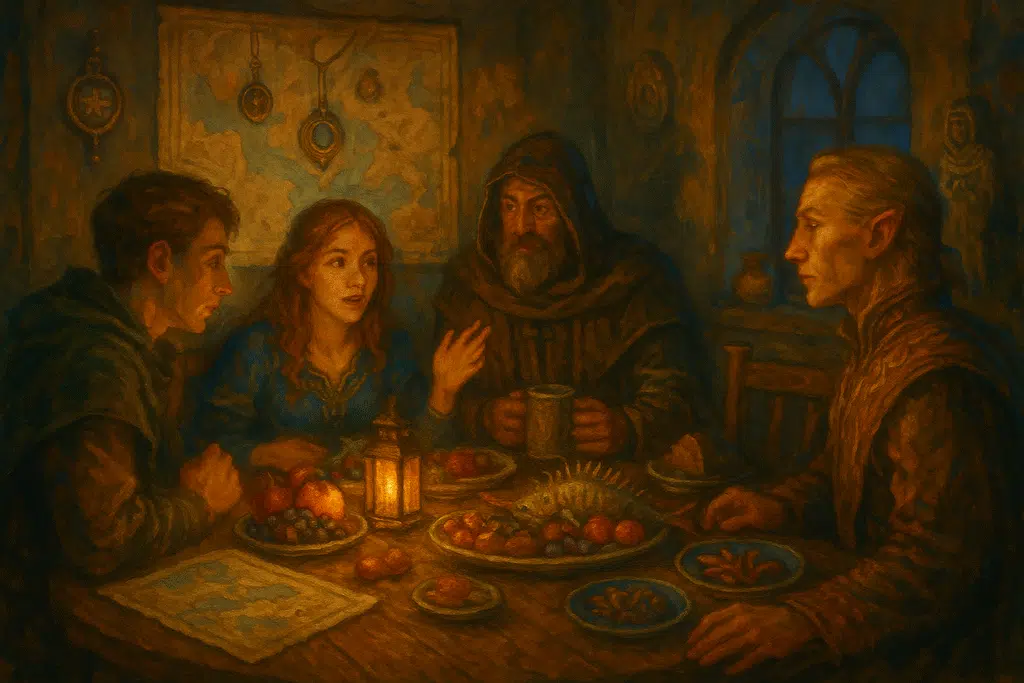
Revealing Your World Without Information Dumps
The art of indirect exposition
Natural worldbuilding revelation occurs through character interaction with environment rather than direct explanation. Characters naturally notice what differs from their expectations, discuss obstacles requiring special knowledge, and explain unfamiliar elements to less experienced companions. These interaction moments provide organic opportunities to reveal world information without stopping narrative momentum. By identifying which characters would reasonably not know certain information, you create natural exposition opportunities through genuine teaching moments rather than artificial explanations.
Conflict situations naturally expose world rules as characters encounter limitations and exploit possibilities within established systems. A character attempting to enter a forbidden area reveals both physical security measures and social consequences for boundary violations; someone navigating social hierarchies demonstrates both formal and informal power structures; negotiations expose value systems and exchange principles. By revealing worldbuilding elements through active problem-solving rather than passive description, you maintain narrative tension while establishing how your world functions.
Sensory experience provides particularly effective worldbuilding revelation by showing how characters physically experience their environment rather than merely describing its characteristics. The weight of particular clothing, the smell of distinctive foods, the sound of unfamiliar languages, or the physical sensation of different gravity all communicate worldbuilding information through immediate experience rather than abstract description. These sensory details simultaneously establish world characteristics and enhance immersion by engaging readers’ experiential imagination rather than their analytical understanding.
Character-driven discovery
Characters with different backgrounds naturally perceive environments differently based on their experience, training, and cultural frameworks. These divergent perspectives create opportunities to highlight different aspects of your world through contrasting observations. For collaborative storytelling experiences, establishing these diverse character perspectives and worldbuilding expectations during foundational planning sessions ensures that all participants understand how their characters would naturally interact with and perceive the shared world. A merchant notices trade goods and pricing anomalies; a soldier identifies defensive vulnerabilities; a religious figure recognizes sacred symbols. By filtering worldbuilding details through appropriate character perspectives, you reveal information that naturally aligns with narrative focus while characterizing your viewpoint figures through their distinctive observations.
Personal histories provide context for worldbuilding revelation through memories, associations, and comparative observations. Characters naturally recall relevant past experiences when encountering similar situations, creating organic opportunities to reveal historical information through personal recollection rather than historical exposition. These subjective historical perspectives simultaneously develop character depth and establish world context without interrupting present-time narrative momentum.
Characters with imperfect understanding create particularly effective worldbuilding vehicles by demonstrating gaps between popular perception and factual reality. Protagonists operating under misconceptions that readers can recognize through contextual clues create dramatic irony while suggesting greater world complexity. By occasionally showing character beliefs contradicted by observable reality, you establish your fictional world as containing the same perception gaps, propaganda effects, and knowledge limitations as real societies, creating authentic complexity rather than perfect transparency.
When to explain and when to imply
Different worldbuilding elements require different revelation approaches depending on their narrative importance and reader familiarity with similar concepts. Elements directly impacting plot understanding typically require clearer explanation than atmospheric details; completely unfamiliar concepts need more explicit introduction than variations on familiar ideas. When determining explanation depth, consider both the consequence of reader misunderstanding and the similarity to known concepts. A unique magic system central to plot resolution requires clearer explanation than an unusual but narratively peripheral cultural practice.
Familiar concepts with specific variations work well with implied worldbuilding, where readers apply existing understanding while noting distinctive differences. Concepts entirely foreign to reader experience require more explicit establishment to prevent misinterpretation. This familiarity spectrum creates natural revelation patterns where recognizable elements provide foundational understanding while unusual features receive focused attention. By leveraging reader knowledge where applicable while clearly establishing genuinely unfamiliar concepts, you create efficient worldbuilding that respects reader intelligence while preventing confusion.
Mystery and ambiguity serve different functions than confusion or vagueness. Intentional mysteries—questions deliberately raised for later resolution—create narrative tension and discovery satisfaction. Confusion—reader uncertainty about already-revealed information—typically indicates exposition failure rather than effective mystery creation. When employing mysterious elements, ensure readers recognize the intentional information gap rather than feeling lost in already-provided explanation. This distinction between strategic mystery and accidental confusion determines whether readers remain engaged or become frustrated with your worldbuilding revelation.
Evolving Questions for Deepening Iterations
Refining your world through multiple passes
Worldbuilding rarely succeeds in a single iteration—compelling fictional universes typically develop through multiple creation passes that progressively deepen complexity and resolve contradictions. First-pass worldbuilding establishes fundamental parameters—physical laws, geographic features, basic social structures—that provide foundation for more detailed development. Subsequent passes add increasingly specific elements while testing earlier decisions for consistency and narrative effectiveness. This layered approach creates more cohesive environments than attempting comprehensive creation in a single effort.
Different worldbuilding passes should focus on different systemic levels, moving from foundational frameworks to specific implementations. Early passes establish base constraints and possibilities; middle-stage development focuses on cultural systems and historical patterns; later iterations develop specific communities and individual experiences within established frameworks. This progressive refinement creates worlds with both coherent underlying structures and convincing surface details rather than disconnected elements lacking systemic integration.
Testing through narrative scenarios reveals worldbuilding weaknesses more effectively than abstract evaluation. By mentally placing characters in different situations within your world and tracing how they would realistically navigate these circumstances, you identify missing elements, logical contradictions, and unexpected implications that require refinement. These narrative tests simultaneously improve worldbuilding cohesion and generate potential story material as you discover interesting conflict situations emerging from your established systems.
How answers create better questions
The most productive worldbuilding occurs when each answer generates new, more specific questions that deepen understanding rather than simply accumulating disconnected facts. When you establish that your world features a particular magic system, this immediately raises questions about who can access these abilities, how they’re trained, what limitations apply, and how society has adapted to their presence. By systematically exploring these second-order and third-order implications, you create densely interconnected worlds where elements naturally influence each other rather than existing in isolation.
Questions requiring integration between previously separate elements often yield particularly valuable insights. Asking how your established economic system interacts with your religious practices, or how your technological development affects family structures, creates connection points between worldbuilding domains that might otherwise remain artificially separated. These integration questions reveal emergent properties that wouldn’t be visible when examining systems in isolation, creating more realistic complexity through interaction effects.
Contradiction questions—asking where established elements might create tensions or inconsistencies—generate particularly rich worldbuilding opportunities. When you notice potential conflicts between different aspects of your world, these apparent problems often highlight realistic friction points that create natural narrative tension. A society valuing both individual achievement and communal harmony contains inherent contradictions that require ongoing negotiation; a world with both advanced medical technology and traditional healing practices generates natural cultural tensions. By exploring rather than eliminating these contradictions, you create worlds with authentic complexity.
Knowing when your foundation is strong enough
Worldbuilding faces diminishing returns beyond certain development thresholds, with additional detailing yielding minimal narrative benefit once foundational systems are solidly established. Rather than pursuing encyclopedic completeness, focus on developing sufficient depth that your world can consistently generate interesting situations and conflicts for your specific narrative needs. A world sufficiently developed to support compelling story exploration serves its purpose regardless of how many details remain undefined beyond narrative requirements.
Different narrative forms require different worldbuilding completion levels. Open-world games or long-running novel series require more comprehensive development than standalone stories or focused narratives. When assessing completion adequacy, consider your specific medium requirements and narrative scope rather than abstract completion standards. The appropriate development level depends entirely on what your particular story needs to function effectively rather than theoretical comprehensiveness.
Worldbuilding reaches sufficient maturity when it generates more questions than it requires. Early-stage development constantly reveals gaps requiring immediate resolution before story can proceed; mature worldbuilding creates interesting exploration opportunities that exceed immediate narrative requirements. This transition from worldbuilding necessity to creative opportunity indicates a foundation strong enough to support dynamic storytelling—a world capable of generating more story possibilities than you’ll likely explore rather than struggling to support your basic narrative needs.
The worlds we create are never truly finished—they continue to breathe and evolve long after we’ve written the last word. Each question you ask is like planting a seed that will grow in unexpected directions, revealing landscapes you couldn’t have imagined at the outset. This organic exploration is what separates perfunctory settings from those that haunt readers’ imaginations for years.
When your world feels as though it existed before your story began and will continue after it ends, you’ve succeeded at something profound—you’ve created not just a stage for characters to perform upon, but a living entity with which they must negotiate, struggle, and ultimately belong. In that space where imagination meets internal logic, stories find their deepest resonance and truth.



